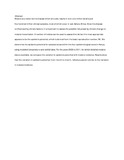| dc.description.abstract | Malaria is a vector-borne disease which annually results in over one million deaths and
five hundred million clinical episodes, most of which occur in sub-Sahara Africa. Since the disease
is influenced by climate factors, it is important to assess the possible risk posed by climate change on
malaria transmission. A number of indices can be used to assess this risk but the most appropriate
appears to be the epidemic potential, which is derived from the basic reproduction number, R0. We
determine the epidemic potential for selected areas within the four epidemiological zones in Kenya,
using modeled temperature and rainfall data. For the years 2009 to 2011, for which detailed malaria
data is available, we compare the variation in epidemic potential with malaria incidence. Results show
that the variation in epidemic potential, from month to month, reflects a pattern similar to the variation
in malaria incidence | en_US |

